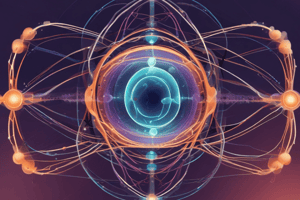Podcast
Questions and Answers
What kind of experiment did J.J. Thomson conduct to show the existence of electrons in an atom?
What kind of experiment did J.J. Thomson conduct to show the existence of electrons in an atom?
- He observed the attraction between a glass rod and an inflated balloon.
- He passed electricity through a gas at high pressure.
- He rubbed two objects together to generate static electricity.
- He observed streams of cathode rays in a discharge tube. (correct)
What do cathode rays consist of?
What do cathode rays consist of?
- Negatively charged particles called electrons (correct)
- Positively charged particles
- Alpha particles
- Neutrally charged particles
What is the significance of an electrically charged object being able to attract an uncharged object?
What is the significance of an electrically charged object being able to attract an uncharged object?
- It indicates the presence of charged particles in matter at the atomic level. (correct)
- It demonstrates the existence of neutrons in atoms.
- It suggests that all matter is electrically neutral.
- It proves that atoms are made up of positive and negative charges.
How did J.J. Thomson observe the cathode rays in his experiment?
How did J.J. Thomson observe the cathode rays in his experiment?
What did J.J. Thomson's discovery of electrons in an atom demonstrate?
What did J.J. Thomson's discovery of electrons in an atom demonstrate?
Why is it said that the mass and charge of cathode ray particles do not depend on the nature of gas in J.J. Thomson's experiment?
Why is it said that the mass and charge of cathode ray particles do not depend on the nature of gas in J.J. Thomson's experiment?
What did Thomson conclude about all atoms based on the formation of cathode rays?
What did Thomson conclude about all atoms based on the formation of cathode rays?
How does Thomson explain the formation of cathode rays?
How does Thomson explain the formation of cathode rays?
How is an electron described based on the information provided?
How is an electron described based on the information provided?
What is the relative mass of an electron compared to a hydrogen atom?
What is the relative mass of an electron compared to a hydrogen atom?
Where are electrons located within an atom?
Where are electrons located within an atom?
What symbol is commonly used to represent an electron?
What symbol is commonly used to represent an electron?




